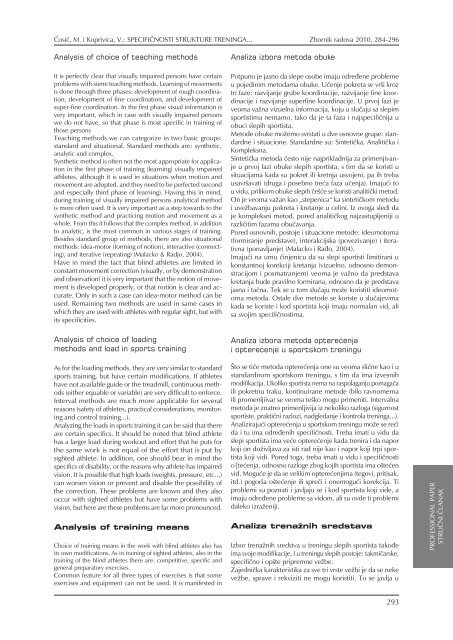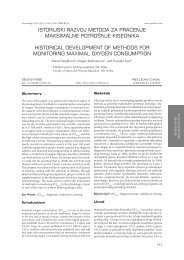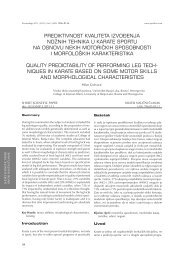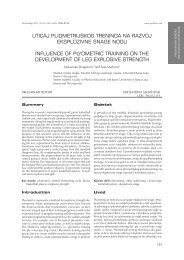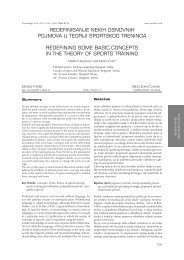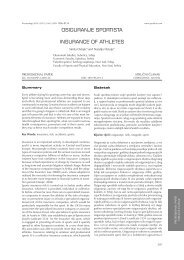specifiÄnosti strukture treninga kod sportista sa oÅ¡teÄenim vidom ...
specifiÄnosti strukture treninga kod sportista sa oÅ¡teÄenim vidom ...
specifiÄnosti strukture treninga kod sportista sa oÅ¡teÄenim vidom ...
You also want an ePaper? Increase the reach of your titles
YUMPU automatically turns print PDFs into web optimized ePapers that Google loves.
Ćosić, M. i Koprivica, V.: SPECIFIČNOSTI STRUKTURE TRENINGA... Zbornik radova 2010, 284-296<br />
Analysis of choice of teaching methods<br />
It is perfectly clear that visually impaired persons have certain<br />
problems with some teaching methods. Learning of movements<br />
is done through three phases: development of rough coordination,<br />
development of fine coordination, and development of<br />
super-fine coordination. In the first phase visual information is<br />
very important, which in case with visually impaired persons<br />
we do not have, so that phase is most specific in training of<br />
those persons<br />
Teaching methods we can categorize in two basic groups:<br />
standard and situational. Standard methods are: synthetic,<br />
analytic and complex.<br />
Synthetic method is often not the most appropriate for application<br />
in the first phase of training (learning) visually impaired<br />
athletes, although it is used in situations when motion and<br />
movement are adopted, and they need to be perfected (second<br />
and especially third phase of learning). Having this in mind,<br />
during training of visually impaired persons analytical method<br />
is more often used. It is very important as a step towards to the<br />
synthetic method and practicing motion and movement as a<br />
whole. From this it follows that the complex method, in addition<br />
to analytic, is the most common in various stages of training.<br />
Besides standard group of methods, there are also situational<br />
methods: idea-motor (forming of notion), interactive (connecting),<br />
and iterative (repeating) (Malacko & Radjo, 2004).<br />
Have in mind the fact that blind athletes are limited in<br />
constant movement correction (visually, or by demonstration<br />
and observation) it is very important that the notion of movement<br />
is developed properly, or that notion is clear and accurate.<br />
Only in such a case can idea-motor method can be<br />
used. Remaining two methods are used in <strong>sa</strong>me cases in<br />
which they are used with athletes with regular sight, but with<br />
its specificities.<br />
Analiza izbora metoda obuke<br />
Potpuno je jasno da slepe osobe imaju određene probleme<br />
u pojedinim metodama obuke. Učenje pokreta se vr{i kroz<br />
tri faze: razvijanje grube koordinacije, razvijanje fine koordinacije<br />
i razvijanje superfine koordinacije. U prvoj fazi je<br />
veoma važna vizuelna informacija, koju u slučaju <strong>sa</strong> slepim<br />
sportistima nemamo, tako da je ta faza i najspecifičnija u<br />
obuci slepih <strong>sportista</strong>.<br />
Metode obuke možemo svrstati u dve osnovne grupe: standardne<br />
i situacione. Standardne su: Sintetička, Analitička i<br />
Kompleksna.<br />
Sintetička metoda često nije najprikladnija za primenjivanje<br />
u prvoj fazi obuke slepih <strong>sportista</strong>, s tim da se koristi u<br />
situacijama kada su pokret ili kretnja usvojeni, pa ih treba<br />
u<strong>sa</strong>vr{avati (druga i posebno treća faza učenja). Imajući to<br />
u vidu, prilikom obuke slepih če{će se koristi analitički metod.<br />
On je veoma važan kao „stepenica“ ka sintetičkom metodu<br />
i uvežbavanju pokreta i kretanje u celini. Iz ovoga sledi da<br />
je kompleksni metod, pored analitičkog najzastupljeniji u<br />
različitim fazama obučavanja.<br />
Pored osnovnih, postoje i situacione metode: ideomotorna<br />
(formiranje predstave), interakcijska (povezivanje) i iterativna<br />
(ponavljanje) (Malacko i Rađo, 2004).<br />
Imajući na umu činjenicu da su slepi sportisti limitirani u<br />
konstantnoj korekciji kretanja (vizuelno, odnosno demonstracijom<br />
i posmatranjem) veoma je važno da predstava<br />
kretanja bude pravilno formirana, odnosno da je predstava<br />
jasna i tačna. Tek se u tom slučaju može koristiti ideomotorna<br />
metoda. Ostale dve metode se koriste u slučajevima<br />
kada se koriste i <strong>kod</strong> <strong>sportista</strong> koji imaju normalan vid, ali<br />
<strong>sa</strong> svojim specifičnostima.<br />
Analysis of choice of loading<br />
methods and load in sports training<br />
Analiza izbora metoda opterećenja<br />
i opterećenje u sportskom treningu<br />
As for the loading methods, they are very similar to standard<br />
sports training, but have certain modifications. If athletes<br />
have not available guide or the treadmill, continuous methods<br />
(either equable or variable) are very difficult to enforce.<br />
Interval methods are much more applicable for several<br />
reasons (<strong>sa</strong>fety of athletes, practical considerations, monitoring<br />
and control training...).<br />
Analyzing the loads in sports training it can be <strong>sa</strong>id that there<br />
are certain specifics. It should be noted that blind athlete<br />
has a larger load during workout and effort that he puts for<br />
the <strong>sa</strong>me work is not equal of the effort that is put by<br />
sighted athlete. In addition, one should bear in mind the<br />
specifics of di<strong>sa</strong>bility, or the reasons why athlete has impaired<br />
vision. It is possible that high loads (weights, pressure, etc...)<br />
can worsen vision or prevent and di<strong>sa</strong>ble the possibility of<br />
the correction. These problems are known and they also<br />
occur with sighted athletes but have some problems with<br />
vision, but here are these problems are far more pronounced.<br />
Analysis of training means<br />
Choice of training means in the work with blind athletes also has<br />
its own modifications. As in training of sighted athletes, also in the<br />
training of the blind athletes there are: competitive, specific and<br />
general preparatory exercises.<br />
Common feature for all three types of exercises is that some<br />
exercises and equipment can not be used. It is manifested in<br />
[to se tiče metoda opterećenja one su veoma slične kao i u<br />
standardnom sportskom treningu, s tim da ima izvesnih<br />
modifikacija. Ukoliko <strong>sportista</strong> nema na raspolaganju pomagača<br />
ili pokretnu traku, kontinuirane metode (bilo ravnomerna<br />
ili promenljiiva) se veoma te{ko mogu primeniti. Intervalna<br />
metoda je znatno primenljivija iz nekoliko razloga (sigurnost<br />
sportiste, praktični razlozi, nadgledanje i kontrola <strong>treninga</strong>...).<br />
Analizirajući opterećenja u sportskom treningu može se reći<br />
da i tu ima određenih specifičnosti. Treba imati u vidu da<br />
slepi <strong>sportista</strong> ima veće opterećenje kada trenira i da napor<br />
koji on doživljava za isti rad nije kao i napor koji trpi <strong>sportista</strong><br />
koji vidi. Pored toga, treba imati u vidu i specifičnosti<br />
oštećenja, odnosno razloge zbog kojih <strong>sportista</strong> ima o{tećen<br />
vid. Moguće je da se velikim opterećenjima (tegovi, priti<strong>sa</strong>k,<br />
itd.) pogor{a o{tećenje ili spreči i onemogući korekcija. Ti<br />
problemi su poznati i javljaju se i <strong>kod</strong> <strong>sportista</strong> koji vide, a<br />
imaju određene probleme <strong>sa</strong> <strong>vidom</strong>, ali su ovde ti problemi<br />
daleko izraženiji.<br />
Analiza trenažnih sredstava<br />
Izbor trenažnih sredstva u treningu slepih <strong>sportista</strong> takođe<br />
ima svoje modifikacije. I u treningu slepih postoje: takmičarske,<br />
specifično i op{te pripremne vežbe.<br />
Zajednička karakteristika za sve tri vrste vežbi je da se neke<br />
vežbe, sprave i rekviziti ne mogu koristiti. To se javlja u<br />
PROFESSIONAL PAPER<br />
STRUČNI ČLANAK<br />
293


